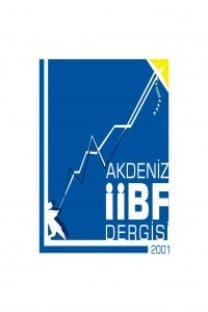THE IMPACT OF MANAGER’S AGE ON LEADERSHIP BEHAVIOUR: A RESEARCH ON A GROUP OF MANAGERS FROM THE BANKING SECTOR
Öz This study aims to determine the extent of the effect of age variable on the leadership behaviour of managers. The age variable has brought a new perspective to leadership research. In this study, a survey was conducted on a gruop of managers in the Turkish banking sector in order to determine the effect of managers’ age on leadership behaviour. Data of the survey was collected by a questionnaire developed by the author on the leadership dimensions of the Leadership Effectiveness Analysis model of Kabacoff. The results of the analysis demonstrated that managers’ age had an impact on the conservative, persuasive, restraint, tactical, communication, delegation, control, feedback, dominance and production behaviours of subjects. Significant difference in these leadership behaviours was found in the age group over 35
THE IMPACT OF MANAGER’S AGE ON LEADERSHIP BEHAVIOUR: A RESEARCH ON A GROUP OF MANAGERS FROM THE BANKING SECTOR
___
Aranda, E., Aranda, L. ve Conlon, K. (1998) Teams: Structure, Process, Culture and Politic, Prentice Hall, New Jersey.Bello-Adeyemi T. (2001) Leaders’ Risk Propensity And Age as Determinants of Organizational Growth In The Not-For-Profit-Sector, Management Research News, Vol.24, No.5, 17-23.
Blau, P. (1977) Inequality And Heterogeneity, New York, N.Y., Free Press.
Bova, B. ve Kroth, M.(2001) Workplace Learning and Generation X, Journal of Workplace Learning, Vol.13, No.2, 57-65.
Blyton, P.(1984) Same Old and New Problem In Employee Decision Making, International Social Science Journal, Vol. 37, No.2, 217-231.
Donnellon, A. (1999) Takım Dili, Sistem Yayıncılık,ùstanbul.
Ertekin, Y. (1993) Stres ve Yönetim, Türkiye Ve Orta Doİu Amme ùdaresi Enstitüsü Yayınları, No.253, Ankara.
Gibson, J. L., Ivancevich, J. ve Donnely J. (1985) Organizational Behavior, Business Publications, Plano, Texas.
Gürgen, H. (1997) Örgütlerdeùletiûim Kalitesi, Der Yayım Evi, ùstanbul.
Halliman, R. (1998) A Coming of Age: A Comparison of Organizational Performance of Baby Boom CEOs To CEOs Born Prior To The Baby Boom Era, Journal of Management History, Vol.4, No.1, 68-74.
Hitt, M. ve Tyler, B. (1991) Strategic Decision Models: Integrating Different Perspectives, Strategic Management Journal, Vol.32, 353-376.
Jurkiewcz, C. L. (2000) Generation X and The Public Employee, Public Personnel Management, 29, 55-81.
Kabacoff, R. ve Stoffey, R. (2001) Age Differences In Organizational Leadership, MRG Portland, USA.
Kabacoff, R. (1998) Gender Differences In organizational Leadership: A Large Sample Study, MRG, Portland, USA.
Kakabadse, A., Kakabadse, N. ve Myers, A. (1998) Demographics and Leadership Philosophy: Exploring Gender Differences, Journal of Management Development, Vol. 17, 351-388.
Koçel, T. (1998) ùûletme Yöneticiliİi:Yönetim ve Organizasyon, Organizasyonlarda Davranıû, Klasik-Modern-Çaİdaû Yaklaûımlar, Beta Basım Yayım Daİıtım A.ş., ùstanbul.
Lawrence, B. (1988) New Wrinkles In The Theory of Age: Demography, Norms and Performance Ratings, Academy of Management Journal, Vol.32, 353-376.
Lee, J. A. (1988) Changes In Managerial Values, 1965-1986, Business Horizons, Vol.31 No.4, 29-37.
Levinson, D. J. (1978) The Seasons Of A Man’s Life, Alfred A. Knopf, Inc., N.Y.
Lok, P. ve Crawford, J. (1999) The Relationship Between Commitment And Organizational Culture, Subculture, Leadership Style and Job Satisfaction in Organizational Change and Development, Leadership and Organization Development Journal, Vol.20, No.7, 365-373.
Mathieu, J. ve Zajac, D. (1990) A Review of Meta- Analysis of The Antecedents, Correlates and Consequences Organizational Commitment, Psychological Bulletin, Vol. 108, No.2, 171-194.
Menon, N. ve Akhilesh, B. (1994) Functionally dependent stress among managers, Journal of Managerial Psychology, Vol.9, No.3, 13-22.
Pedler, M., Burgoyne, J. ve Boydell, T.(1991) The Learning Company, McGraw Hill, N.Y.
Pfeffer, J. (1983) Organizational Demography, In L.L. Cumming’s And B. Staw (Eds.), Research In Organizational Behavior, Vol.5, Greenwich, J. Al Press.
Schermerhorn, J., Hunt, J. ve Osborn, R. (1997) Organizational Behavior, J.W. and Sons, Inc., N.Y.
Sawyer, C. (1998) MRG’s Unique Approach To Questionnaire Design, MRG, Portland Maine, USA.
Staw, B. ve Ross, J.(1977) Commitment To A Policy Decision: A Multi- Theoretical Perspective, Administrative Science Quarterly, Vol.23, 40-64.
Thomas- Coulson, C. (1990) Too old at 40?, Executive Development, Vol. 3, No.2.
Wah, L. (1999) Older Bosses Are Best, Management Review, No.88, 7.
Weiss, D. (1993) Baûarılı Ekip Oluûturma, Rota Yayın Yapım Daİıtım, ùstanbul.
Wiener, Y. (1988) Forms of Value Systems, Academy of Management Review, Vol.13, No.4, 537-544.
Yousef, A. (1998) Correlates of Perceived Leadership Style In A Culturally Mixed Environment, Leadership and Organization Development Journal, Vol. 19, No.5, 275-284.
Yukl, G. A.(1994) Leadership In Organizations, Prentice-Hall, Englewood Cliffs, N.Y.
Zenger, T. ve Lawrence, B. (1989) Organizational Demography: The Differential Effects of
Age and Tenure Distributions on Technical Communication, Academy of Management Journal, Vol.32, 35.
- ISSN: 1302-9975
- Başlangıç: 2001
- Yayıncı: Akdeniz Üniversitesi
Sayıdaki Diğer Makaleler
A PARCH MODELLING OF THE IMKB INDEX
EFFICIENCY OF ECONOMIC INTERVENTIONS OF GOVERNMENT
A FIELD RESEARCH ON THE ADAPTATION PROBLEM OF RETURNED EMIGRANTS’ CHILDREN
EUROPEAN SECURITY AND DEFENCE POLICY AND TURKEY
UN ESSAI D’ANALYSE DES RELATIONS ARMEE-POUVOIR DANS LES PAYS SOUS-DEVELOPPES
